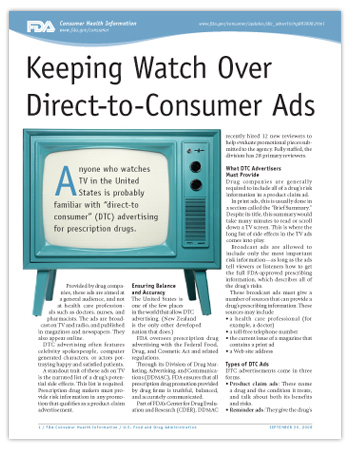For Consumers
Keeping Watch Over Direct-to-Consumer Ads
Printer-friendly PDF (267 KB)  |
 Get Consumer Updates by E-mail
Get Consumer Updates by E-mail
- Ensuring Balance and Accuracy
- What DTC Advertisers Must Provide
- Types of DTC Ads
- A Topic of Debate
- FDA's Role
- Online Guide for Consumers
Anyone who watches TV in the United States is probably familiar with "direct-to consumer" (DTC) advertising for prescription drugs.
Provided by drug companies, these ads are aimed at a general audience, and not at health care professionals such as doctors, nurses, and pharmacists. The ads are broadcast on TV and radio, and published in magazines and newspapers. They also appear online.
DTC advertising often features celebrity spokespeople, computer generated characters, or actors portraying happy and satisfied patients.
A standout trait of these ads on TV is the narrated list of a drug's potential side effects. This list is required. Prescription drug makers must provide risk information in any promotion that qualifies as a product-claim advertisement.
Ensuring Balance and Accuracy
The United States is one of the few places in the world that allows DTC advertising. (New Zealand is the only other developed nation that does.)
The Food and Drug Administration (FDA) oversees prescription drug advertising with the Federal Food, Drug, and Cosmetic Act and related regulations.
Through its Division of Drug Marketing, Advertising, and Communications (DDMAC), FDA ensures that all prescription drug promotion provided by drug firms is truthful, balanced, and accurately communicated.
What DTC Advertisers Must Provide
Drug companies are generally required to include all of a drug's risk information in a product claim ad.
In print ads, this is usually in a section called the "Brief Summary." Despite its title, this summary would take many minutes to read or scroll down a TV screen. This is where the long list of side effects in the TV ads comes into play.
Broadcast ads are allowed to include only the most important risk information—as long as the ads tell viewers or listeners how to get the full FDA-approved prescribing information, which describes all of the drug's risks.
These broadcast ads must give a number of sources that can provide a drug's prescribing information. These sources may include
- a health care professional (for example, a doctor)
- a toll-free telephone number
- the current issue of a magazine that contains a print ad
- a Web site address
Types of DTC Ads
DTC advertisements come in three forms.
- Product claim ads: These name a drug and the condition it treats, and talk about both its benefits and risks.
- Reminder ads: They give the drug's name, but not the drug's uses.
- Help-seeking ads: These describe a disease or condition, but don't recommend or suggest specific drugs.
A Topic of Debate
While DTC advertising has many supporters, it raises concerns for many people.
Proponents say that the ads
- provide useful information to consumers that may result in better health
- can advance public health by encouraging more people to talk with health care professionals about problems, particularly undertreated conditions such as high blood pressure and high cholesterol
- can help remove the stigma associated with diseases that in the past were rarely openly discussed (including erectile dysfunction and depression)
- can remind patients to get their prescriptions refilled and help them adhere to their medication regimens
However, many people are concerned that such promotion
- may contain false or misleading information
- does not provide enough information about the risks and negative effects of the advertised drugs
- may not advance—and may even threaten—the public health
- encourages overuse of prescription drugs
- encourages use of the most costly treatments, instead of less expensive treatments that would be just as satisfactory
FDA's Role
FDA encourages companies that offer DTC advertising to include accurate information in their ads. Through a comprehensive surveillance and enforcement program, the agency ensures that consumers are not misled or deceived by advertisements that violate the law.
In addition, FDA advances and encourages better communication of labeling and promotional information to health professionals and to consumers.
Online Guide for Consumers
FDA's Web site, Be Smart About Prescription Drug Advertising, A Guide for Consumers, is designed to educate consumers about how to view DTC advertising, prepare them for discussions with health care professionals, and help improve patient understanding and medical care.
The site includes these tips:
- Your health care professional is the best source of information about the right medicines for you.
- Prescription drug advertisements can provide useful information for consumers to work with their health care professionals to make wise decisions about treatment.
- If you think a prescription drug ad violates the law, contact FDA's Division of Drug Marketing, Advertising, and Communications (DDMAC).
The online guide also provides the following:
- Interactive example ads – The guide offers example ads for fictitious drugs to illustrate the different requirements for different types of ads. This helps users learn in both a visual and written manner.
- A list of questions to ask – Consumers can print out a list of questions they should ask themselves when they see a prescription drug ad. This can help discussions with their health care professionals.
- A site-specific survey – Users can answer the survey by clicking on the "Give us Feedback" tab. This is an opportunity to give FDA feedback about how well the site addresses users' needs.
The Web page also offers information on "The Basics" of drug ads and a question-and-answer section.
This article appears on FDA's Consumer Updates page, which features the latest on all FDA-regulated products.
Updated: May 10, 2010








